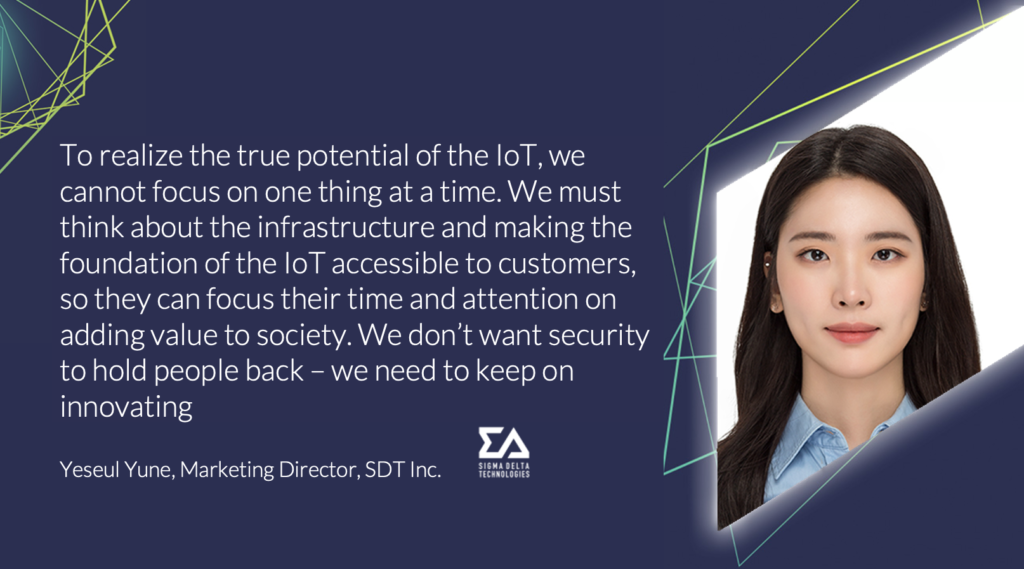The following article is written by our partners at SDT Inc. as part of our In conversation with … series.
You do not have to look too hard to see the potential benefits of the Internet of Things (IoT). A quick scan of a home or office will show us how connected devices are being used to make us feel more comfortable and secure. More excitingly, IoT is starting to make impacts beyond the home into streets and cities. In fact, our streets are becoming safer and our cities are operating more efficiently because of the use of IoT technologies. On top of this, there are the benefits we do not see. Greater connectivity means the companies that are responsible for our underground infrastructure, such as our utilities networks, have the information they need to maintain services and keep their people safe.
As an example, one of our customers is using our IoT module to monitor the temperature, humidity, oxygen saturation, gas concentration, and water level under manholes. The data that is being captured is used to alert workers to problems, so they can prevent damage to key assets and avoid potentially dangerous situations, such as an outbreak of fire or rising water levels.
In safety-critical environments like this, people rely on the information that is being generated by connected devices. So, if they are going to put their trust in the technologies and the data, we have to make sure they are secure.
Making the Case for Security
Unfortunately, some people in the industry believe they can do without security, especially if they develop low-cost IoT devices – but we disagree. After you deploy devices at scale – rolling out hundreds or even thousands of products across several countries – they are beyond the reach of the manufacturer. If they have been shipped without security, there is nothing to stop a hacker from disrupting, disabling or taking over those devices.
Even for the companies that recognize the importance of secure devices, the challenge for many innovators is building their device with security in mind. To do this, companies need highly skilled people and access to resources such as hardware, firmware, software, and cloud technologies if they want to build a connected product – and they are hard to attract and develop.
How Device Makers can Help Secure the IoT
The good news is that there are movements to make security simpler for customers. In our case, we provide the building blocks for anyone that wants to connect their products and services to the internet. That could be a home appliance, utility meter, automotive or medical device. Our IoT system-on-modules integrate with operating systems, connectivity, security and cloud solutions and they are designed to enable customers to start work on their IoT applications immediately and focus their resources on the expansion of their services. Our devices utilize the ST Microelectronics STM32 family of microcontrollers and software from Arm Mbed OS. Importantly for us, they are both PSA Certified.
With the PSA Certified security framework and assurance scheme, we know the hardware and software we are building on has security at its core. We have also chosen to certify our products to PSA Certified Level 1 as it helps us overcome a significant challenge: demonstrating to our customers that their products and data are secure because our modules have the right level of security built in.
Watch the video to learn more about our solution:
Securing Our Future
With more secure devices entering the market, it’s natural to question whether the investment in security is worth it. However, we believe we reap the benefits in what security unlocks for our customers, and society.
Firstly, connected devices are gathering extraordinary volumes of data that will be invaluable to the businesses of the future. In the past, it was a race to get your product to market. The winner was the company that made the first smartphone, for example, or the fastest car. In that sense, there were clear leaders in each industry. Now, it is not straightforward, and it is not always about being first. Instead, end users are starting to request quality goods, services and data that have more features, are customized to their requirements and act responsibly when it comes to security.
Secondly, we expect there will be one trillion connected devices by 2035. That is an ambitious prediction and it relies on exponential growth in the market, but if we reach that number, it will change the world. Italian physicist, Carlo Rovelli, once said words to the effect of: ‘the world is made of events, not things’. Although we describe an Internet of Things, what we are actually pursuing is an internet of events. That is because even in the era of one trillion connected devices, it is not the products that will be different. What they enable is what makes the IoT truly interesting and intriguing to people.
To make that happen, we cannot focus on one thing at a time. We have to think about the infrastructure and making the foundation of the IoT accessible to customers, so they can focus their time and attention on adding value to society. We don’t want security to hold people back – we need to keep on innovating.

We Wouldn’t Build a House on Shaky Foundations…
Science gave us the ability to model the world around us, and our understanding has grown from that. The IoT will expand the domain of modeling and become the new stepping stone for human achievement. Security will be at the heart of all of this – we need to imagine that the foundations we are putting in place now and are setting us up in the future. We wouldn’t build a house on shaky foundations, and the same has to be said for the IoT.
